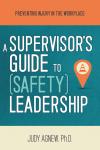Setting Supervisors up for Safety Success: 5 Tips for Building Engagement
No matter the industry, in all my years of experience working across organizations, from the hourly workforce to the executive team, I have always found the most difficult job to be frontline supervision. Frontline supervisors have tremendous pressure from all directions. Their responsibilities are many and their decision making power and control is limited. To add to their challenges, frontline supervisors often have limited experience managing people. Many are promoted to supervision, not because of people management skills, but because of technical expertise. While technical expertise is important, it doesn’t help them with the most challenging part of their job—managing the men and women who work for them.
Ironically, it’s the frontline supervisor who has the most influence on the performance of the people who actually produce the products and/or deliver the service. This is particularly true in safety. Frontline supervisors are the linchpins of safety. They bring all the pieces of safety management together. They are responsible for executing the vision and values at the frontline, ensuring procedures are complied with, implementing a myriad of safety decisions and ultimately ensuring that the workforce is safe. Their role requires them to motivate and engage frontline employees to participate fully in safety and yet they rarely have adequate training or coaching in how to do it.
Engagement requires good leadership skills. The old-style command and control management that is too often the model for supervision simply will not foster engagement. Here are 5 ways frontline supervisors can improve their leadership skills and engage their direct reports in safety improvement:
- Build Relationships. It’s no coincidence that supervisors who have strong relationships with their crews tend to have safer crews. Time spent working on getting to know direct reports, showing care and concern and building trust pays off in spades. Employees who feel like a valued part of a team rather than just a pair of hands to get the job done are much more likely to be engaged.
- Respond to Hazards. Frontline employees gauge how truly important safety is in an organization by management’s willingness to take care of hazardous conditions. When management does a good job of taking care of hazards, employees are willing to participate more fully in safety. Since frontline supervisors are the "face" of management, it is important they do all they can to remediate safety hazards.
- Encourage Near Miss Reporting. Near misses uncover weaknesses in safety systems and processes that, in turn, enable changes to be made to prevent future incidents. Unfortunately, most frontline employees avoid reporting near misses out of fear of negative consequences. Supervisors need to be deliberate in their use of positive reinforcement when near misses are reported in order to tap into this valuable source of information.
- Eliminate Blame. Blame is the enemy of engagement, but is too often the outcome of incident investigations. In truth, most safety incidents are the coming together of a number of factors (conditions, behaviors, systemic weaknesses). To pin the blame on one person or one act is almost always overly simplistic. Even in cases where an employee clearly did something that contributed to the incident, blame (and the negative consequences that usually follow) rarely solves the problem. By working to understand and eliminate the behavioral root causes, supervisors will strengthen prevention and build engagement.
- Use More Positive Reinforcement. Being truly engaged in safety is voluntary. An employee who works hard but doesn’t speak up at safety meetings, report hazards, or provide feedback to a peer is not likely to get fired. Engagement is discretionary and the only way to get discretionary effort is through positive reinforcement. By more frequently acknowledging what employees do well, supervisors can not only strengthen safe behaviors, they can also foster engagement.
Frontline supervisors who are skilled at building engagement earn the respect and commitment from their team, improve overall performance and keep workers safe on the job.
 For more on developing frontline supervision skills, read A Supervisor’s Guide to (Safety) Leadership.
For more on developing frontline supervision skills, read A Supervisor’s Guide to (Safety) Leadership.



